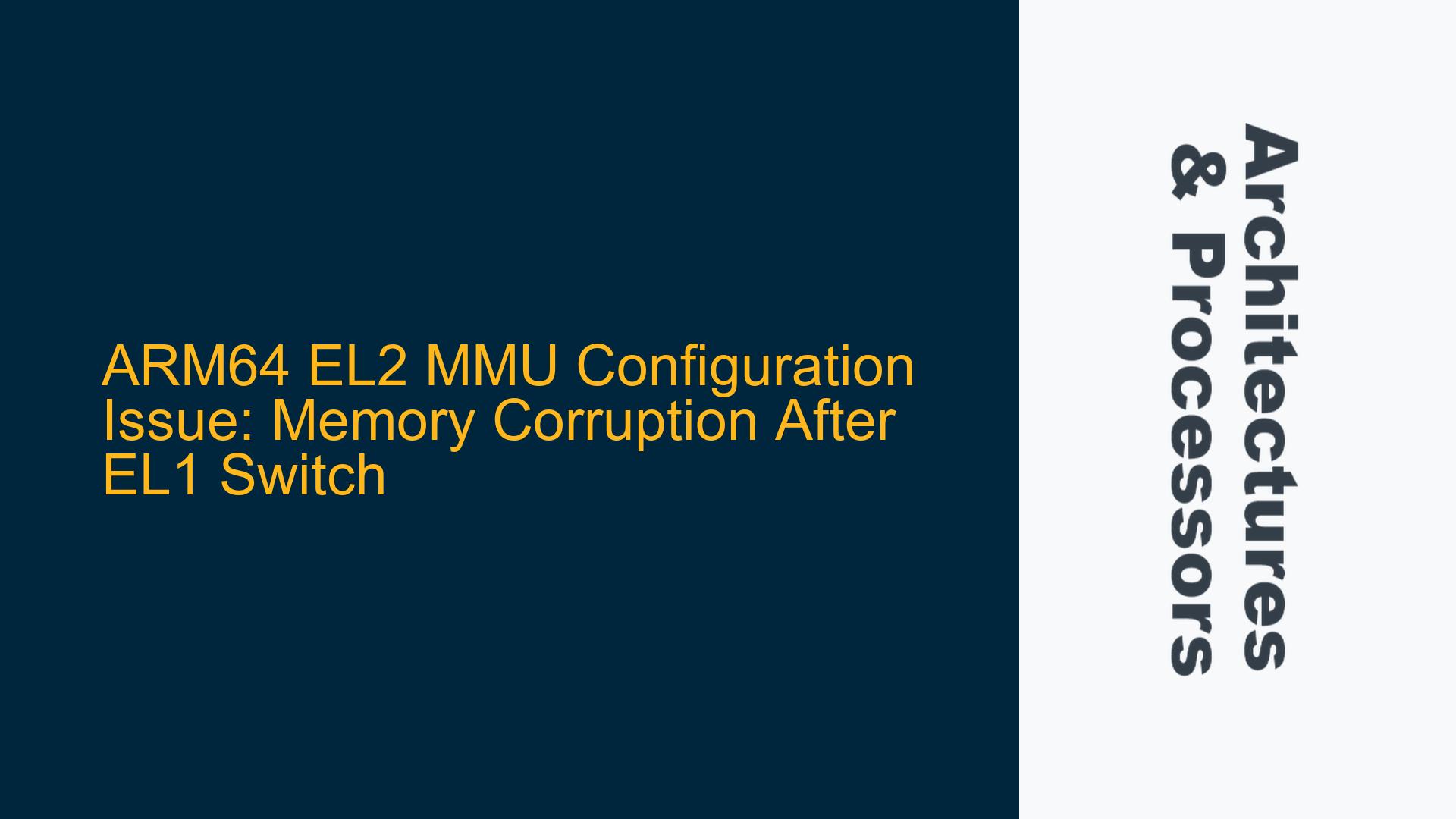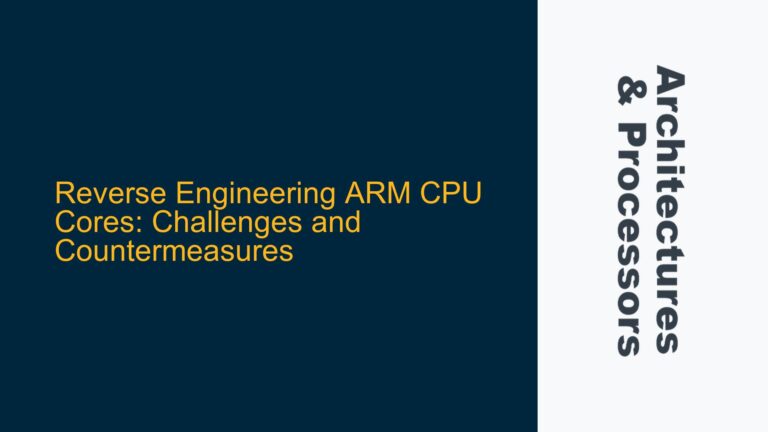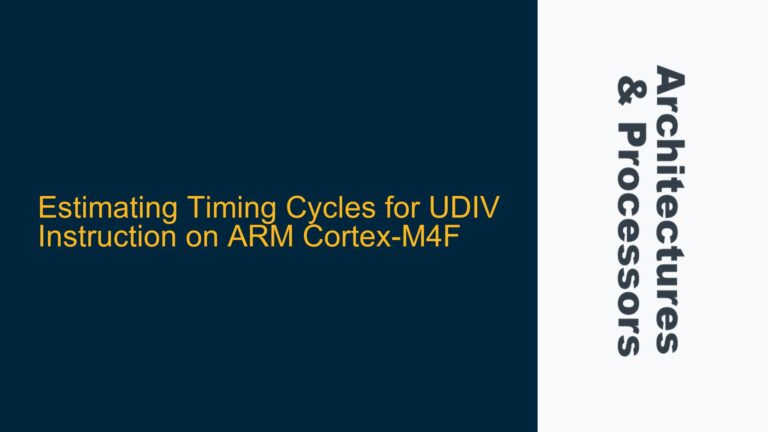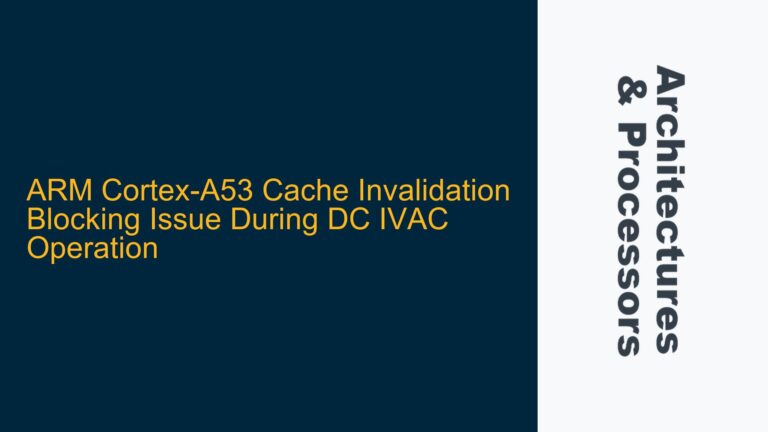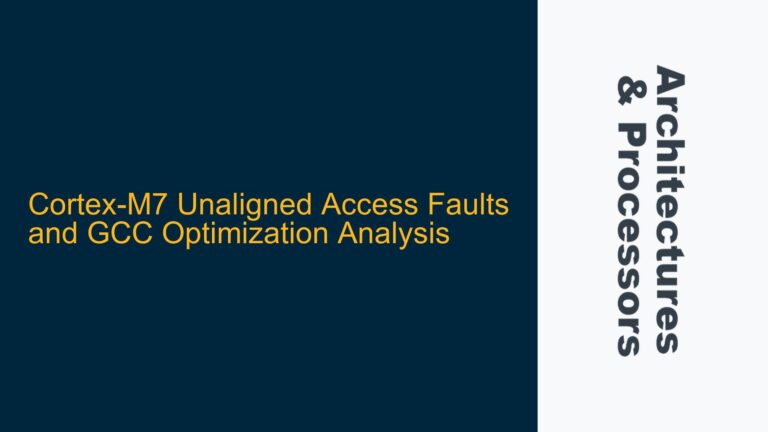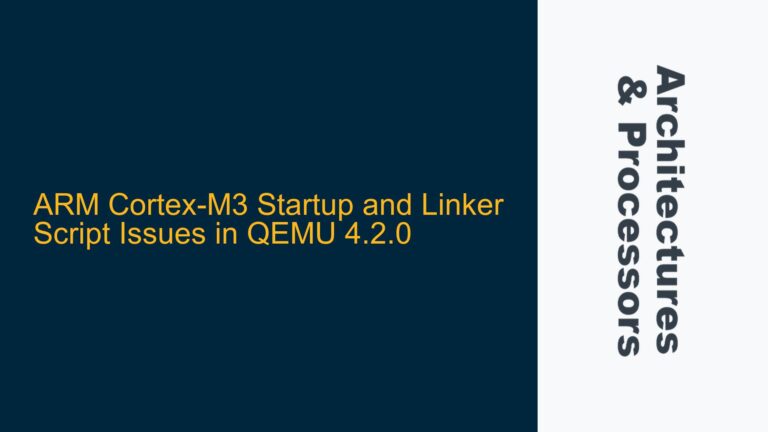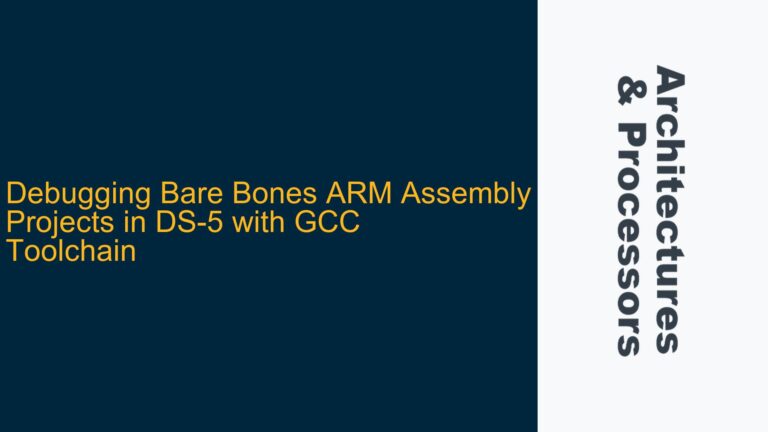ARM Cortex-A53 Stage-2 MMU Misconfiguration Leading to Memory Corruption
The core issue revolves around memory corruption observed after switching from Exception Level 2 (EL2) to Exception Level 1 (EL1) on an ARM Cortex-A53 processor. The system is configured with a Stage-2 Memory Management Unit (MMU) using a 64KB granule and 512MB block mappings. The Intermediate Physical Address (IPA) and Physical Address (PA) are set to a one-to-one mapping. While the code executes correctly in EL2, the memory contents become corrupted after the ERET instruction transitions execution to EL1. Debugging reveals that the memory contains valid data before the ERET instruction but is corrupted afterward. This suggests a misconfiguration in the Stage-2 MMU setup or a missing synchronization step during the transition.
The Stage-2 MMU is responsible for translating IPAs to PAs in a virtualized environment. The configuration involves setting up the Virtualization Translation Table Base Register (VTTBR_EL2), the Virtualization Translation Control Register (VTCR_EL2), and the page tables. The provided code snippet shows the initialization of these registers and the page table entries. However, the corruption issue indicates that the translation or memory attributes might not be correctly applied when the system switches to EL1.
Missing Memory Synchronization and Incorrect Page Table Attributes
The memory corruption issue can be attributed to several potential causes. First, the Stage-2 MMU configuration might lack proper memory synchronization barriers or cache management operations. The Data Synchronization Barrier (DSB) and Instruction Synchronization Barrier (ISB) instructions are used to ensure that memory operations are completed before proceeding. However, their placement and usage in the provided code might not be sufficient to guarantee correct behavior during the EL2-to-EL1 transition.
Second, the page table attributes might be incorrectly configured. The provided code sets up the first page table entry with specific attributes, including memory type and access permissions. However, the attributes might not align with the requirements for Stage-2 translation. For example, the memory type might not be set to a type that ensures coherency between the CPU and the MMU. Additionally, the access permissions might not be correctly configured for EL1 execution.
Third, the HCR_EL2 register configuration might be incomplete or incorrect. The HCR_EL2 register controls various virtualization features, including Stage-2 translation and the execution state of lower exception levels. The provided code sets the VM bit (bit 0) to enable Stage-2 translation and the RW bit (bit 31) to ensure that EL1 executes in AArch64 mode. However, other bits in HCR_EL2 might need to be configured to ensure proper behavior during the transition.
Finally, the Saved Program Status Register (SPSR_EL2) and Exception Link Register (ELR_EL2) might not be correctly set up. The SPSR_EL2 register defines the processor state to be restored after the ERET instruction, while the ELR_EL2 register specifies the address to which execution should return. If these registers are not correctly configured, the processor might enter an unexpected state after the transition, leading to memory corruption.
Implementing Correct Memory Synchronization and Page Table Configuration
To resolve the memory corruption issue, the following steps should be taken to ensure proper Stage-2 MMU configuration and synchronization:
-
Verify Page Table Attributes: Ensure that the page table entries are correctly configured with the appropriate memory type and access permissions. The memory type should be set to a type that ensures coherency between the CPU and the MMU. For example, the Normal Memory type with Write-Back caching is typically used for most memory regions. The access permissions should be set to allow read and write access for EL1.
-
Add Missing Memory Synchronization Barriers: Ensure that the DSB and ISB instructions are correctly placed to guarantee that all memory operations are completed before proceeding. For example, a DSB SY instruction should be added after the page table entry configuration to ensure that the write to the page table is completed before enabling the MMU. Similarly, an ISB instruction should be added after enabling the MMU to ensure that the new translation regime is in effect.
-
Check HCR_EL2 Configuration: Verify that the HCR_EL2 register is correctly configured to enable Stage-2 translation and set the execution state of EL1. In addition to setting the VM and RW bits, ensure that other bits in HCR_EL2 are correctly configured. For example, the AMO, IMO, and FMO bits should be set to route interrupts to EL2 if necessary.
-
Validate SPSR_EL2 and ELR_EL2 Configuration: Ensure that the SPSR_EL2 and ELR_EL2 registers are correctly configured to define the processor state and return address after the ERET instruction. The SPSR_EL2 register should be set to the desired processor state, including the exception level, execution state, and interrupt masks. The ELR_EL2 register should be set to the address of the code to be executed in EL1.
-
Perform Cache Maintenance Operations: Ensure that cache maintenance operations are performed to invalidate or clean the caches as necessary. For example, the TLBI VMALLE1 instruction should be used to invalidate all Stage-1 TLB entries, and a DSB SY instruction should be added afterward to ensure that the TLB invalidation is completed.
-
Debugging and Verification: Use a debugger to verify that the memory contents are correct before and after the ERET instruction. Set breakpoints at key points in the code to inspect the values of the registers and memory locations. Use the debugger to step through the code and verify that the MMU is correctly configured and that the memory contents are not corrupted.
By following these steps, the memory corruption issue can be resolved, and the system can correctly transition from EL2 to EL1 with the Stage-2 MMU properly configured. The key is to ensure that all memory operations are correctly synchronized, the page table attributes are correctly set, and the processor state is correctly configured for the transition.
Detailed Explanation of Key Concepts
Stage-2 MMU and Virtualization
The Stage-2 MMU is a critical component in ARM virtualization, responsible for translating Intermediate Physical Addresses (IPAs) to Physical Addresses (PAs). This translation is necessary in a virtualized environment where multiple virtual machines (VMs) share the same physical hardware. The Stage-2 MMU ensures that each VM operates in its own isolated memory space, preventing one VM from accessing the memory of another VM.
The Stage-2 MMU is controlled by the VTTBR_EL2 and VTCR_EL2 registers. The VTTBR_EL2 register holds the base address of the Stage-2 translation tables, while the VTCR_EL2 register controls the translation parameters, such as the granule size and the number of levels in the translation tables.
Memory Synchronization Barriers
Memory synchronization barriers are essential in ensuring that memory operations are correctly ordered and completed before proceeding. The ARM architecture provides several types of barriers, including Data Synchronization Barriers (DSB), Instruction Synchronization Barriers (ISB), and Data Memory Barriers (DMB).
- DSB SY: Ensures that all memory accesses before the barrier are completed before any memory accesses after the barrier.
- ISB: Ensures that all instructions before the barrier are completed before any instructions after the barrier.
- DMB: Ensures that memory accesses before the barrier are ordered with respect to memory accesses after the barrier.
These barriers are particularly important when configuring the MMU, as they ensure that the new translation regime is correctly applied and that the processor does not execute instructions using stale translations.
Page Table Attributes
Page table entries in the ARM architecture contain various attributes that control how memory is accessed and cached. These attributes include:
- Memory Type: Defines the type of memory, such as Normal Memory or Device Memory. Normal Memory can be further divided into Write-Back, Write-Through, and Non-Cacheable types.
- Access Permissions: Defines the access permissions for the memory region, such as Read-Only, Read-Write, or Execute-Never.
- Shareability: Defines whether the memory region is shared between multiple processors or cores.
- Execute-Never: Prevents the memory region from being executed as code.
These attributes must be correctly configured to ensure that the memory is accessed and cached as intended.
HCR_EL2 Configuration
The HCR_EL2 register controls various aspects of virtualization, including Stage-2 translation and the execution state of lower exception levels. Key bits in HCR_EL2 include:
- VM (bit 0): Enables Stage-2 translation.
- RW (bit 31): Defines the execution state of EL1. When set to 1, EL1 executes in AArch64 mode.
- AMO, IMO, FMO (bits 5, 6, 7): Route asynchronous aborts, IRQs, and FIQs to EL2.
- TGE (bit 27): When set to 1, traps general exceptions to EL2.
These bits must be correctly configured to ensure that the system behaves as expected during the transition from EL2 to EL1.
SPSR_EL2 and ELR_EL2
The SPSR_EL2 and ELR_EL2 registers are used to save and restore the processor state during exception handling. The SPSR_EL2 register holds the processor state to be restored after the ERET instruction, while the ELR_EL2 register holds the address to which execution should return.
The SPSR_EL2 register includes fields for the exception level, execution state, interrupt masks, and condition flags. These fields must be correctly set to ensure that the processor enters the desired state after the ERET instruction.
The ELR_EL2 register must be set to the address of the code to be executed in EL1. This address must be valid and correctly aligned.
Conclusion
The memory corruption issue observed after switching from EL2 to EL1 on an ARM Cortex-A53 processor is likely due to a misconfiguration in the Stage-2 MMU setup or missing synchronization steps. By carefully verifying the page table attributes, adding missing memory synchronization barriers, checking the HCR_EL2 configuration, and validating the SPSR_EL2 and ELR_EL2 registers, the issue can be resolved. Proper debugging and verification using a debugger are also essential to ensure that the system behaves as expected. With these steps, the system can correctly transition from EL2 to EL1 with the Stage-2 MMU properly configured, ensuring reliable and consistent memory access.
